|

ORTAKÖY İÇİN |
|
|
|
Ortaköy is a town 53 kms. southeast of the
province of Çorum.It is situated at the north of Central Anatolia,
to the south of Black Sea Mountain Range and at the end of Kelkit
Valley which is the entrance to Anatolia from the Caucasus. To the
east lies Amasya,and to the southwest, Yozgat. Şapinuwa is
situated 3 kms. southwest of Ortaköy. It can be reached, as well
as with the highway from Corum, either with Sungurlu-Alaca-Kizilli-Ortakoy
route or with Amasya-Goynucek route.
|
|
THE SITE OF ORTAKOY-ŞAPINUWA
Ortakoy Hittite City is aflat and extensive settlement situated on
the plateau stretching as terraces on the northern slopes of the
Valley of Özderesi, a tributary of the Çekerek River.The
Hittitesdid not settle on the mounds where the local people of the
regionhad been living, but created a city on a large, fiat land
which is 3 kms. in the east-west direction and 2.5 kms. in the
north-south direction.The strategic location of Şapinuwa is very
important. |
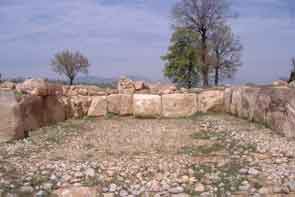 |
|
Themountains surrounding the city, the plateau
ascending in terraces on the Amasya Plain,and the fortification
facilities starting as far as 5 kms. enable the city to be easily
defendable. Since the city
has a key location in between Alaca and Amasya plains, as long as
the city, which is two-days distance from Hattu§as, stands still,
the roads to Bogazkoy-Hattusas are under control. As well as there
are traces of military and religious architecture of the upper
city on the hills to the west, the need for water and timber were
being supplied from these hills. |
|
IMPORTANCE OF ORTAKÖY-ŞAPİNUVA
The Hittites has a prominent place in the history of Anatolia.They
are the first who established a political unity in Anatolia, and
are one of the most important nations at their times . The
scarcity of information about them and their sophisticated
civilisation have always been the center of interest. Although
previously we were being informed with the excavations at the
Hittite centers, such as Bogazkoy and Masathoyiik, today Ortakoy
excavations is supplying extremely important data to the
archaeological world.
|
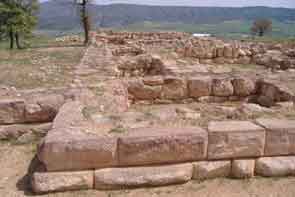 |
supplying extremely important data to
the archaeological world.The architectural materials, excellent
construction technique, the symmetrical ground plan, and the
valuable cuneiform archive found until now at Ortakoy -Şapinuwa
excavations shed light to many unknowns of thousands of years ago.
At Ortakoy archive, place and personal names appear very
frequently. |
| ago. At Ortakoy
archive, place and personal names appear very frequently. The
newly discovered geographical names are of a nature that will
clarify many of the controversial topics on the geography of
Anatolia at the Hittite era. Şapinuwa had been localised in the
past to the southeast of Bogazkoy by the scientists with the
notion that it should be close to the Hurri region. However, the
identification of Şapinuwa with Ortakoy have shifted many of the
city names to the northeast of Anatolia. |
ARCHITECTURAL REMAINS AND FINDS AT
ŞAPINUWA BUILDING "A"
At Şapinuwa, an important structure was uncovered with
the excavations which began in 1990. The building lies at a
dominant point on the plateau, and has a location with an
impressive view. This monumental building has a symmetrical plan.
In the present ground level, limestone and sandstone blocks have
been used at the base of the structure underneath the mudbrick
superstructure These blocks seem to have been arranged in a
Cyclopian order. |
| A great care and skill are
clearly visible at the joints between the block. The height of the
foundation reaches some 2 metres above the ground, and the
width is about 2 metres. Concluding from this wide foundation and
scattering of mudbricks some 10 metres away from the building we
may assume that the building was originally at least two-storeys
high. |
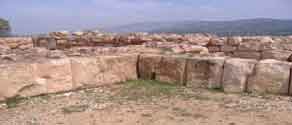 |
|
The building has witnessed afire and
therefore, has been destroyed. Due to agricultural activities,
mudbricks that should have been laid on the foundation have been
greatly destroyed. It was also used as a cemetery in the
Roman times. This 3500 vears old building which is an engineering
and architectural wonder covers an area of 100x25 sq.m., and the
excavations are still being carried out. Whatever purpose the
building "A" serves, whether it be administrative or religious, it
has definitely a considerable importance for Ortakoy-Şapinuwa with
its unique architecture, small finds, and tablet archive. |
|
BUILDING "B"
İn 1995 excavations started at Kadilar Höyük, 150 metres
southeast of building "A". At the foundation of building "B".
plain-eat blocks have been uncovered. On top of these foundation
blocks which are arranged in two rows, 110 cm.wide mud-brick walls
were found .On these mudbrick walls uncovered a well-polished,
straw-added, 3.5-4 cm. thick plaster. Beside the ground level of
this building, a second storey made of an intense timber structure
was evidenced with the burned beams which have fallen down with
the remains of another .
|
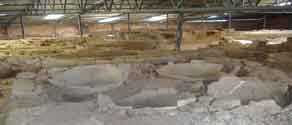 |
storey. Only a section of this building full
ofpithoi, which, therefore, may be called a depot, has been
excavated. There are over 30 pithoi found until now where food or
drink was kept. |
|
SMALL FINDS
in building "A", where the the
excavations are still in progress, around 3000 tablels and tablet
fragments have been found in a Hiltite cuneiform archive. These
tablets and tablet fragments have been uncovered in a deposition
layer of upper storey ruins. There are three seper-ute archive
locations in this monumental building.These tablets include
various topics such as religious, political, military,
administrative, and fortune-telling matters. The archive mainly
consists of letters. There are texts written in Hurrian, Hitto-Hurrian
and Akkadian as well as in Hittite. After a close examination of
the archive, it has been understood, besides the identification of
|
Şapinuwa with Ortakoy, that Ortakoy had
been a residential town for the great Hittite king, had been
an administrative, political, military and religious center,
had had a close contact with Hattusas, and had had a number of
cities in its administrative boundaries. In Ortakoy excavations, in addition to this
important archive, there have been carefully manufactured dark
gray, buff, and terracotta coloured, well-polished and well-fired
common ware, as well as mostly buff and terracotta coloured,
slipped ritual vesselsAmong those are plates, hydria, jugs,
juglets, andpithoi. |
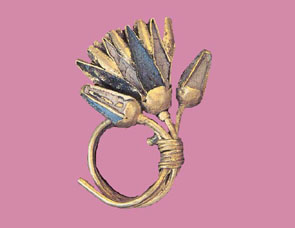 |
Although not too many in number, there are
metal objects which can be considered as fine examples of the
Hittite era, such as arrowheads, bronze axe and dagger. Among the
golden pieces is a golden object with palmette motif, which gives
valuable dues for the relations between Anatolia and Egypt.
Another important group of finds are the triangular objects which
are thought to be used at rituals. ; Especially the one made out
of obsidian is very striking. Moreover, there are seal impressions
in the Hittite hieroglyph.
|
|
Alıntı:Ortaköy Şapinuva Arkeoloji Araştırmaları kitapçığı. |
|